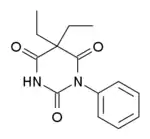 | |
| Clinical data | |
|---|---|
| Other names | Phetharbital |
| ATC code |
|
| Identifiers | |
| |
| CAS Number |
|
| PubChem CID | |
| ChemSpider |
|
| UNII | |
| CompTox Dashboard (EPA) | |
| ECHA InfoCard | 100.006.015 |
| Chemical and physical data | |
| Formula | C14H16N2O3 |
| Molar mass | 260.293 g·mol−1 |
| 3D model (JSmol) | |
| |
| |
| | |
Phetharbital (phenetharbital) is a barbiturate derivative. It has anticonvulsant effects and relatively weak sedative action, and is considered to have a low abuse potential.[1]
References
| GABAergics | |||||
|---|---|---|---|---|---|
| Channel modulators | |||||
| Others |
| ||||
| |||||
This article is issued from Wikipedia. The text is licensed under Creative Commons - Attribution - Sharealike. Additional terms may apply for the media files.